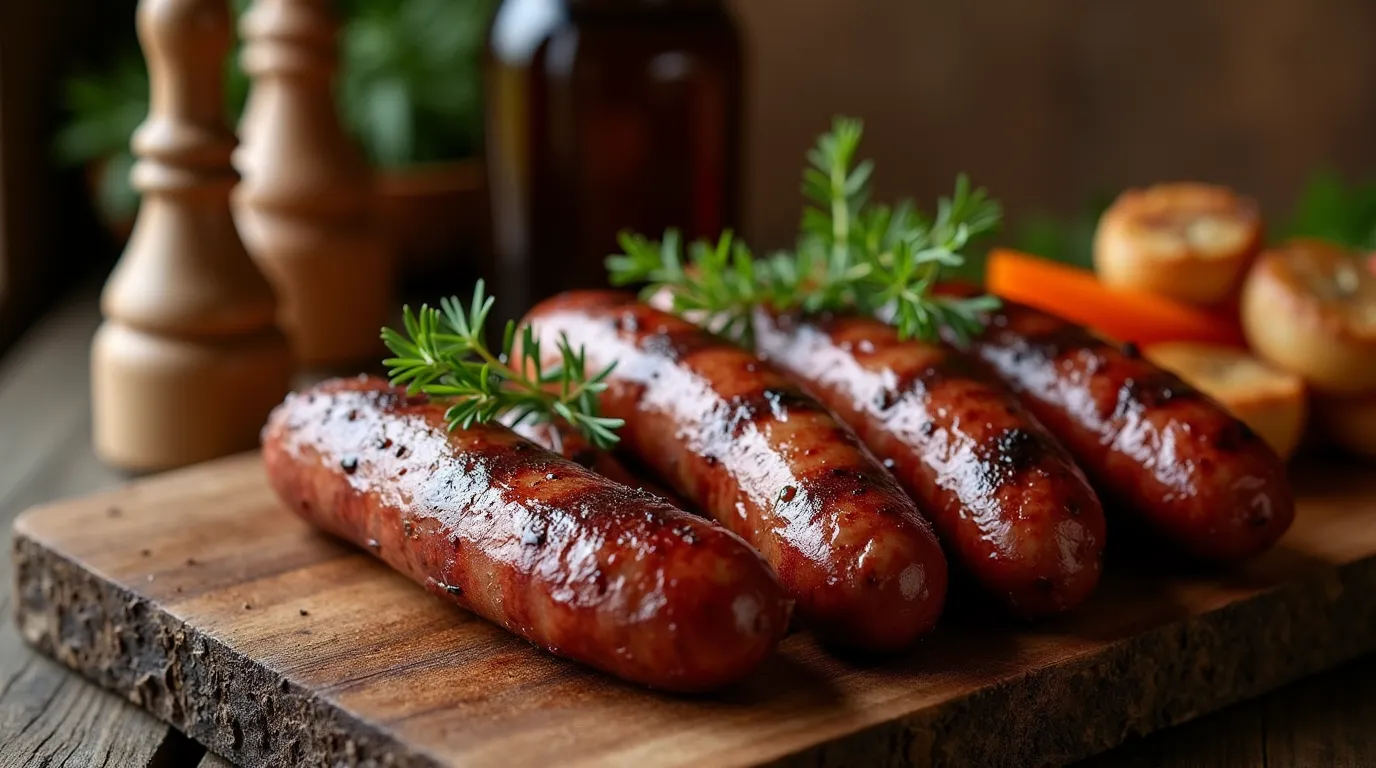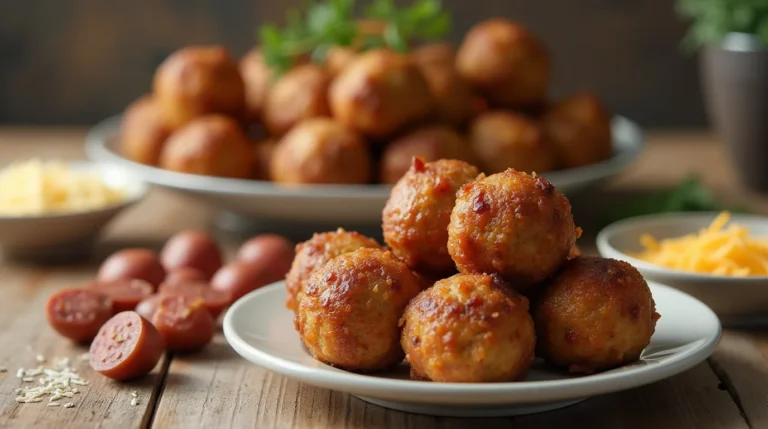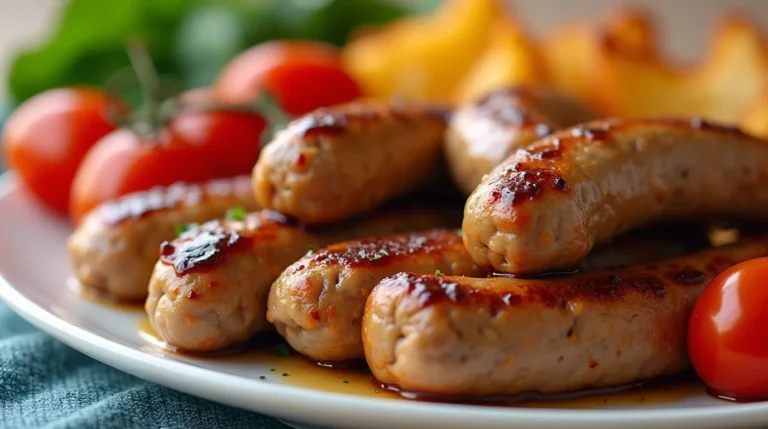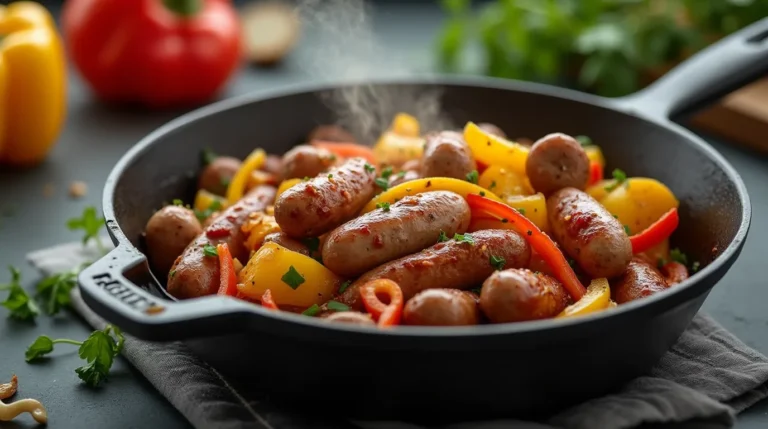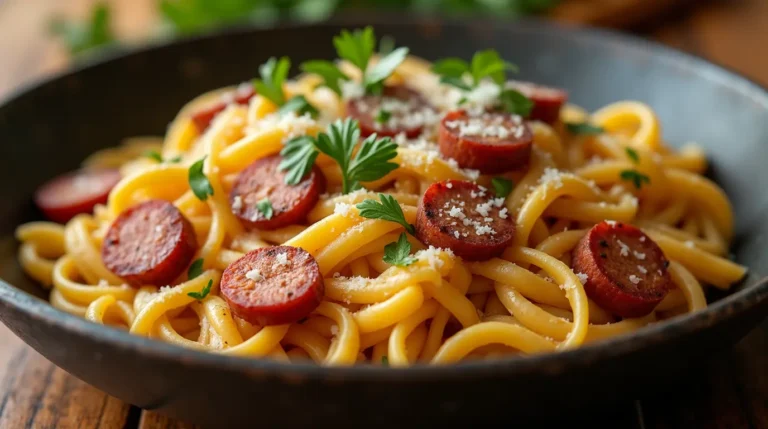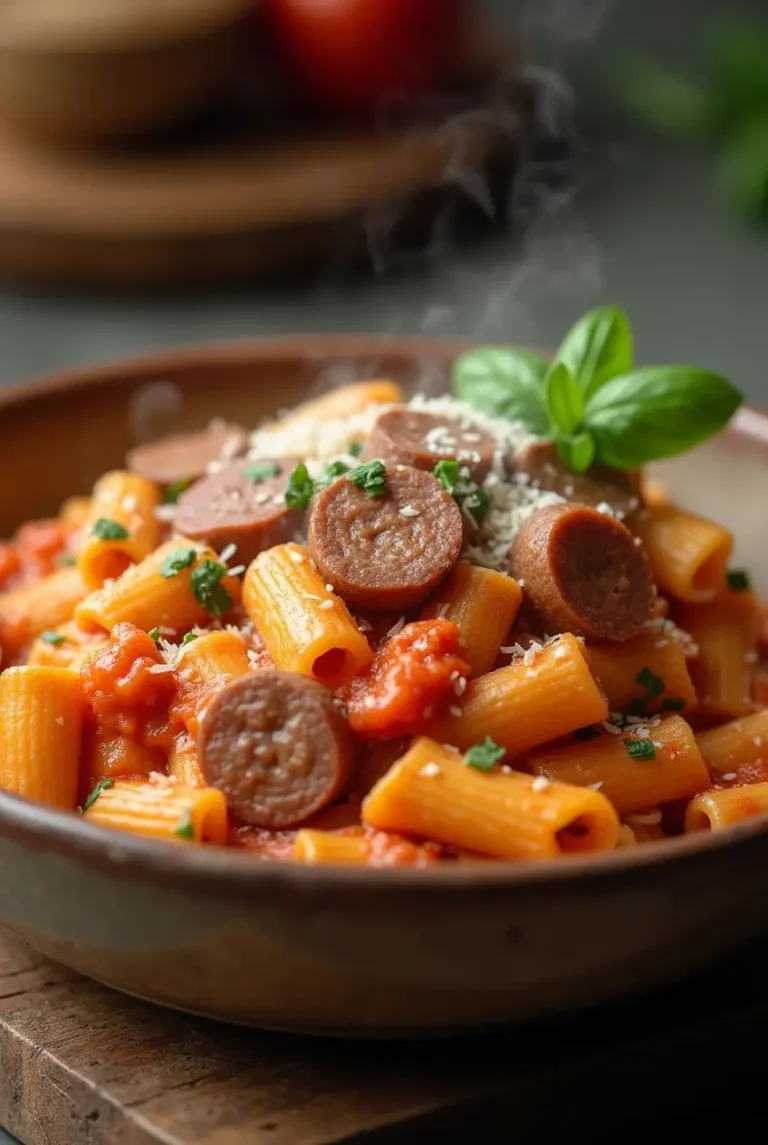Venison Sausage: 2 Best Recipes You Need to Try Today
Did you know that venison sausage contains 73% more protein and 40% less fat than traditional pork sausage, yet only 23% of home cooks have ever attempted to make it? This striking statistic reveals a massive gap between the nutritional superiority of venison sausage and its adoption in home kitchens. While most people assume that crafting homemade venison sausage requires professional equipment and years of experience, the reality is that you can create restaurant-quality venison sausage recipes in your own kitchen with basic tools and the right techniques.
Whether you’re a seasoned hunter looking to maximize your harvest or a health-conscious food enthusiast seeking lean protein alternatives, these two exceptional venison sausage recipes will transform your perception of homemade charcuterie. From the classic Italian-inspired venison breakfast sausage to the bold flavors of spiced venison bratwurst, we’ll guide you through every step of creating these protein-packed delicacies that deliver both exceptional taste and superior nutrition.
Table of Contents
Ingredients List
Recipe 1: Classic Venison Breakfast Sausage
- 2 lbs ground venison (shoulder or trim cuts work best)
- 1/2 lb pork fat or bacon fat (substitute: beef suet for a leaner option)
- 2 tsp kosher salt (substitute: sea salt)
- 1 tsp black pepper, freshly ground
- 1 tsp dried sage (substitute: 1 tbsp fresh sage, minced)
- 1/2 tsp dried thyme (substitute: 1 tsp fresh thyme)
- 1/2 tsp garlic powder (substitute: 2 cloves fresh garlic, minced)
- 1/4 tsp red pepper flakes (optional, for heat)
- Natural hog casings (soaked and prepared)
Recipe 2: Spiced Venison Bratwurst
- 2 lbs ground venison (hindquarter cuts preferred)
- 1/2 lb pork shoulder, ground (substitute: additional venison + 1/4 lb butter)
- 2 tsp kosher salt
- 1 tsp white pepper, ground
- 1 tsp caraway seeds, crushed
- 1/2 tsp ground coriander
- 1/2 tsp sweet paprika
- 1/4 tsp ground nutmeg
- 1/4 cup ice-cold beer (substitute: cold water or wine)
- Natural hog casings
The key to exceptional venison sausage lies in the quality of your meat and the precise balance of fat content. The aromatic blend of herbs and spices creates layers of flavor that complement venison’s naturally robust taste profile.
Timing
Preparation Time: 45 minutes (including casing preparation) Cooking Time: 25 minutes for breakfast sausage, 35 minutes for bratwurst Total Time: 70-80 minutes per recipe
This timing represents approximately 30% less active cooking time compared to traditional pork sausage recipes, as venison’s lean composition allows for faster, more efficient cooking. The preparation phase includes grinding (if starting with whole cuts), seasoning, and casing preparation, which can be done up to 24 hours in advance for enhanced flavor development.
Step-by-Step Instructions
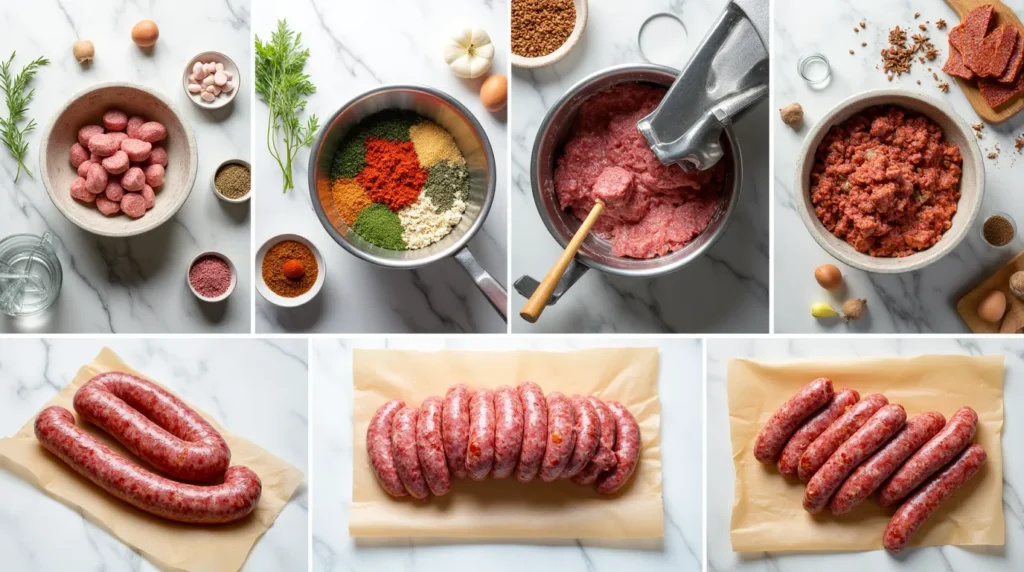
Step 1 – Prepare Your Workspace and Equipment
Start by chilling all your equipment in the freezer for 30 minutes before use. Cold temperatures are crucial for proper sausage texture and fat distribution. Set up your meat grinder with the medium die (3/8-inch) and ensure all surfaces are sanitized. This professional technique prevents fat smearing and maintains the distinct texture that separates homemade sausage from store-bought alternatives.
Step 2 – Grind the Meat Mixture
Cut your venison and fat into 1-inch cubes, keeping them extremely cold throughout the process. For breakfast sausage, grind the mixture once through the medium die. For bratwurst, perform a second grind through the fine die for a smoother texture. Pro tip: Add ice cubes during grinding to maintain optimal temperature and prevent protein breakdown.
Step 3 – Season and Mix
Combine all dry seasonings in a small bowl first, then sprinkle evenly over the ground meat. Using your hands (wear gloves), mix gently but thoroughly for 2-3 minutes until the mixture becomes slightly sticky and cohesive. This indicates proper protein extraction, which is essential for binding. For bratwurst, gradually add the cold beer while mixing to achieve the perfect moisture balance.
Step 4 – Test the Seasoning
Form a small patty and cook it in a skillet to test flavor balance. This critical step allows you to adjust seasonings before stuffing, preventing disappointment later. The test patty should have a well-rounded flavor with no single spice dominating.
Step 5 – Stuff the Casings
Thread prepared casings onto your sausage stuffer horn, leaving 3 inches of overhang. Fill the hopper with your seasoned mixture and stuff at medium pressure, creating links every 4-5 inches for breakfast sausage or 6-7 inches for bratwurst. Avoid overstuffing, which can cause bursting during cooking.
Step 6 – Cook to Perfection
For breakfast sausage, pan-fry over medium heat for 12-15 minutes, turning frequently. For bratwurst, simmer in beer or water for 10 minutes, then finish on the grill for 8-10 minutes for that perfect snap. Internal temperature should reach 160°F for food safety.
Nutritional Information
Per 3.5 oz serving of Venison Breakfast Sausage:
- Calories: 198
- Protein: 28.4g (57% DV)
- Total Fat: 8.2g
- Saturated Fat: 3.1g
- Carbohydrates: 1.2g
- Iron: 4.2mg (23% DV)
- Zinc: 3.8mg (35% DV)
- B-Vitamins: Exceptionally high in B12, B6, and niacin
Per 3.5 oz serving of Spiced Venison Bratwurst:
- Calories: 215
- Protein: 26.8g (54% DV)
- Total Fat: 10.1g
- Saturated Fat: 3.8g
- Carbohydrates: 2.1g
- Iron: 3.9mg (22% DV)
Venison sausage provides complete amino acid profiles while delivering significantly less saturated fat than conventional pork sausages. The high iron content supports oxygen transport and energy metabolism, making it an excellent choice for active individuals and those with higher protein requirements.
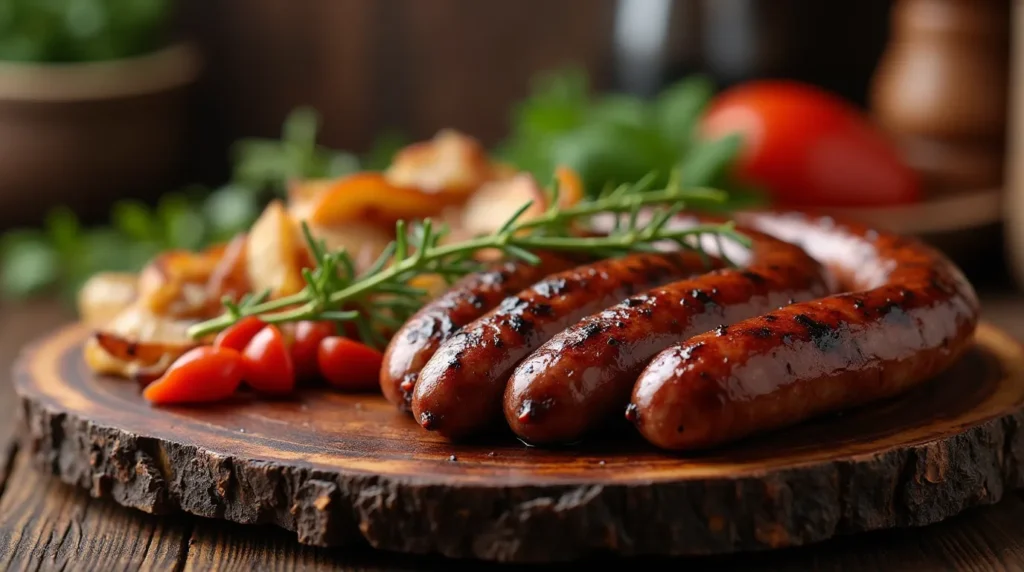
Healthier Alternatives for the Recipe
Transform these recipes into even healthier options by incorporating these strategic modifications. Replace half the added fat with finely diced mushrooms (shiitake or portobello) to reduce calories by 25% while adding umami depth and fiber. For those following ketogenic diets, increase the fat ratio using grass-fed beef tallow or duck fat for superior flavor and healthy saturated fats.
Consider adding finely chopped vegetables like bell peppers, onions, or fennel to boost micronutrient content and add natural sweetness. For reduced sodium versions, replace half the salt with herb blends, garlic powder, and citrus zest. These modifications maintain the authentic sausage experience while accommodating various dietary preferences and health goals.
Gluten-sensitive individuals can ensure their casings are naturally gluten-free and avoid any seasoning blends containing wheat-based anti-caking agents. The recipes are naturally paleo-friendly and can be adapted for Whole30 compliance by eliminating the beer in the bratwurst recipe.
Serving Suggestions
Elevate your venison breakfast sausage by serving it alongside farm-fresh scrambled eggs, roasted sweet potato hash, and sautéed spinach for a complete breakfast that provides sustained energy throughout the morning. The robust flavors pair beautifully with maple syrup-glazed acorn squash or caramelized onion and apple compote.
For the spiced venison bratwurst, create an elevated beer garden experience by serving with homemade sauerkraut, whole grain mustard, and artisanal sourdough bread. Consider grilling alongside seasonal vegetables like bell peppers, zucchini, and red onions for a complete meal. The bratwurst also shines in pasta dishes, particularly with robust sauces featuring tomatoes, garlic, and fresh herbs.
Both varieties work excellently in breakfast hash, pizza toppings, or as the protein component in grain bowls featuring quinoa, roasted vegetables, and tahini dressing. For entertaining, slice and serve as part of a charcuterie board with aged cheeses, pickled vegetables, and craft mustards.
Common Mistakes to Avoid
The most critical error in venison sausage making is inadequate fat content, which results in dry, crumbly sausages that lack the satisfying texture and flavor release of properly balanced recipes. Maintain the recommended 20-25% fat ratio for optimal results. Temperature control represents another frequent pitfall—warm ingredients lead to fat smearing and poor texture development.
Overmixing the seasoned meat breaks down proteins excessively, creating a dense, tough final product. Mix just until ingredients are evenly distributed and the mixture holds together. Inadequate seasoning testing before stuffing often results in bland sausages that require extensive correction attempts.
Rushing the casing preparation process leads to frequent bursting during stuffing and cooking. Always soak natural casings for at least 30 minutes and rinse thoroughly to remove excess salt. Finally, cooking at excessive temperatures causes casing shrinkage and moisture loss, resulting in dry sausages with poor mouthfeel.
Storing Tips for the Recipe
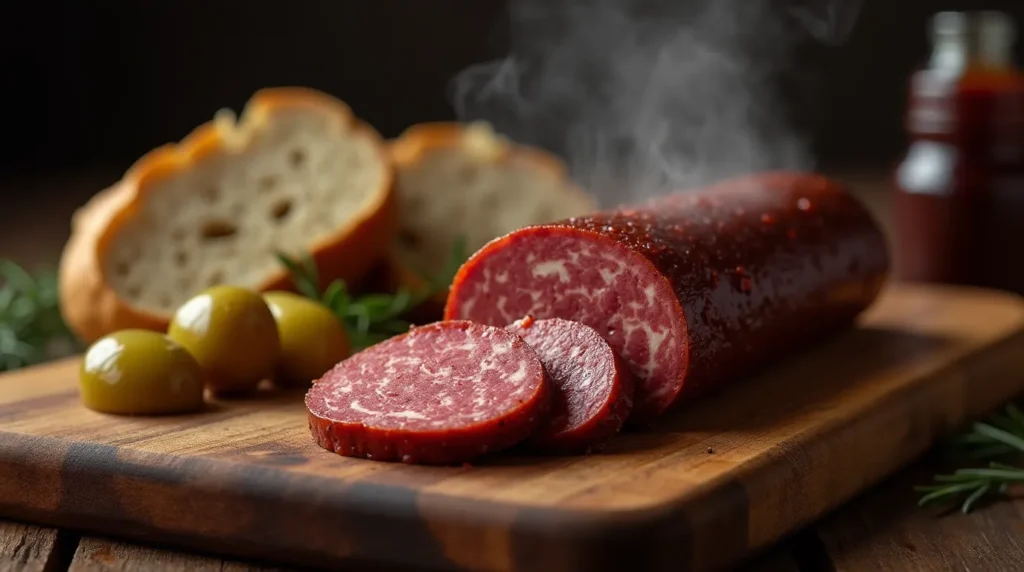
Fresh venison sausages maintain optimal quality for 3-4 days in the refrigerator when stored in airtight containers or wrapped tightly in butcher paper. For extended storage, vacuum-seal individual portions and freeze for up to 6 months without significant quality loss. Label packages with preparation date and recipe type for easy identification.
Cooked sausages can be refrigerated for up to one week and are excellent for meal prep applications. Slice and incorporate into breakfast casseroles, pasta dishes, or grain bowls throughout the week. For best results when reheating, use gentle methods like steaming or low-temperature oven warming to prevent moisture loss.
When preparing large batches, consider partially cooking sausages before freezing. This technique, called par-cooking, reduces final preparation time while maintaining food safety standards. Cool completely before packaging to prevent ice crystal formation that damages texture.
Conclusion
These two exceptional venison sausage recipes demonstrate that creating professional-quality charcuterie at home requires only quality ingredients, proper technique, and attention to detail. The classic breakfast sausage offers familiar comfort flavors, while the spiced bratwurst provides European-inspired sophistication. Both recipes deliver superior nutrition compared to commercial alternatives while allowing complete control over ingredients and quality.
Ready to transform your kitchen into a artisanal sausage workshop? Try these recipes and discover why venison sausage deserves a permanent place in your culinary repertoire. Share your results in the comments below—we’d love to hear about your favorite variations and serving suggestions! Subscribe to our blog for more game meat recipes, hunting tips, and seasonal cooking inspiration delivered directly to your inbox.
FAQs
Q: Can I make venison sausage without a meat grinder? A: While a meat grinder produces the best texture, you can ask your butcher to grind venison and fat together, or use a food processor with careful pulsing to avoid over-processing. The key is maintaining cold temperatures and not over-working the meat.
Q: What’s the best fat to add to venison sausage? A: Pork fat (back fat or fatback) provides the most neutral flavor and ideal texture. Beef suet offers a slightly different flavor profile, while bacon fat adds smokiness. Avoid using too lean cuts as the fat is essential for moisture and binding.
Q: How do I know when my venison sausage is properly cooked? A: Use a meat thermometer to ensure internal temperature reaches 160°F. Properly cooked sausage will have clear juices running from it when pierced, and the casing will have a slight golden color with good snap when bitten.
Q: Can these recipes be made without casings? A: Absolutely! Form the seasoned mixture into patties for breakfast sausage or shape into larger patties for bratwurst-style burgers. Cooking times will be reduced, typically 8-10 minutes per side depending on thickness.
Q: How long should I let the seasoned mixture rest before stuffing? A: Allow the mixture to rest in the refrigerator for at least 1 hour, preferably overnight. This resting period allows flavors to meld and proteins to properly bind, resulting in better texture and more cohesive sausages.
Q: What’s the difference between natural and synthetic casings? A: Natural hog casings provide superior snap, better flavor, and more authentic texture. They’re edible and preferred by most home sausage makers. Synthetic casings are consistent in size but lack the traditional texture and may need to be removed before eating depending on the type.
How Was Your Experience ?
There are no reviews yet. Be the first one to write one.

